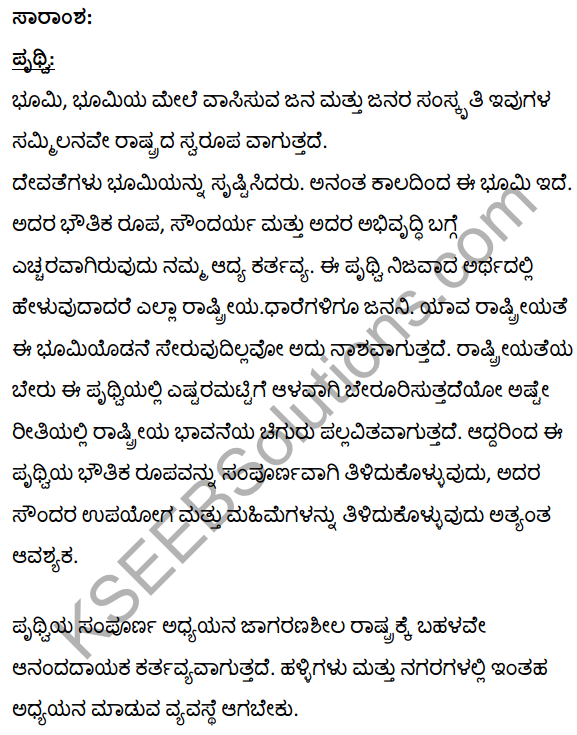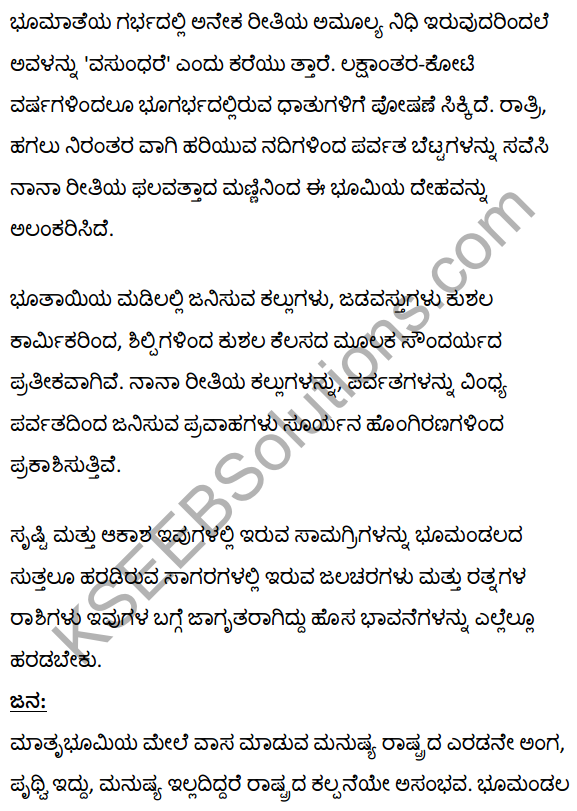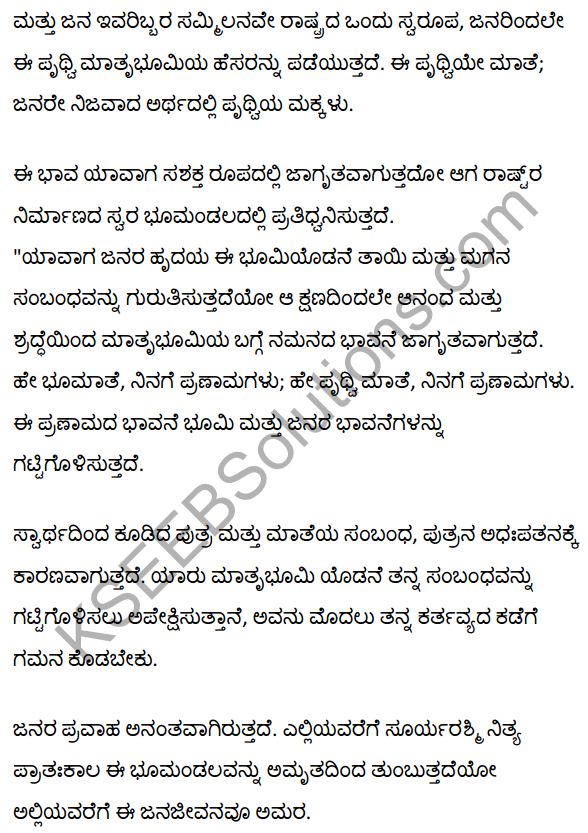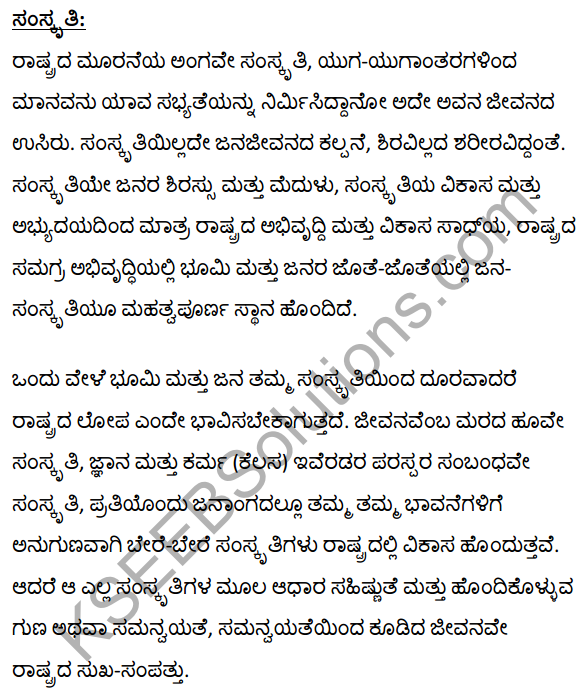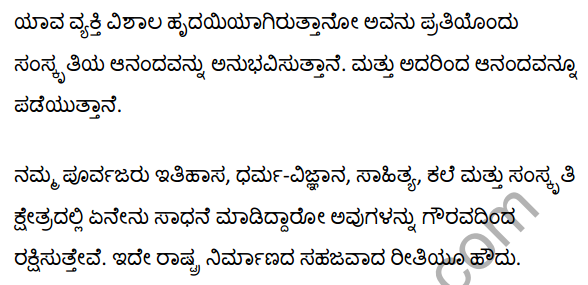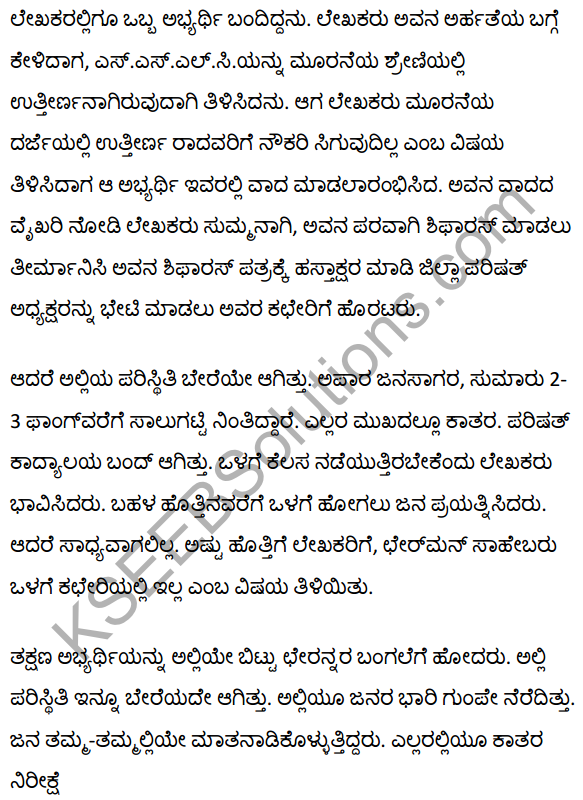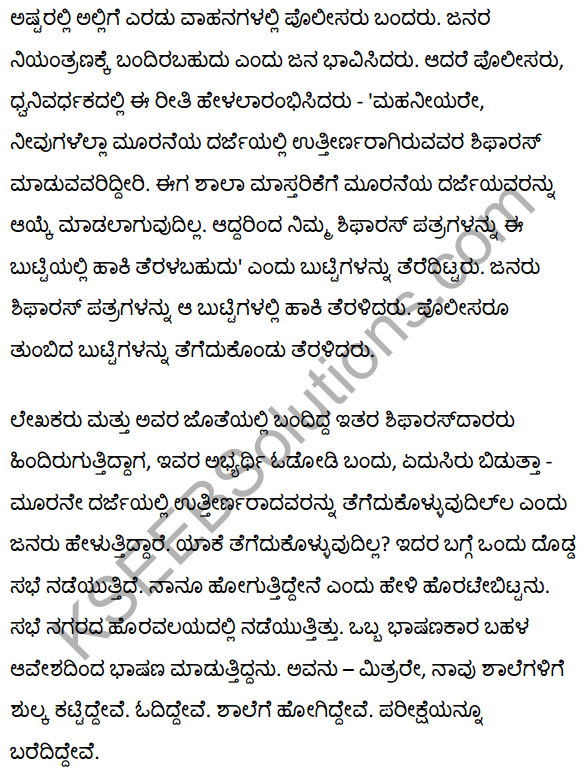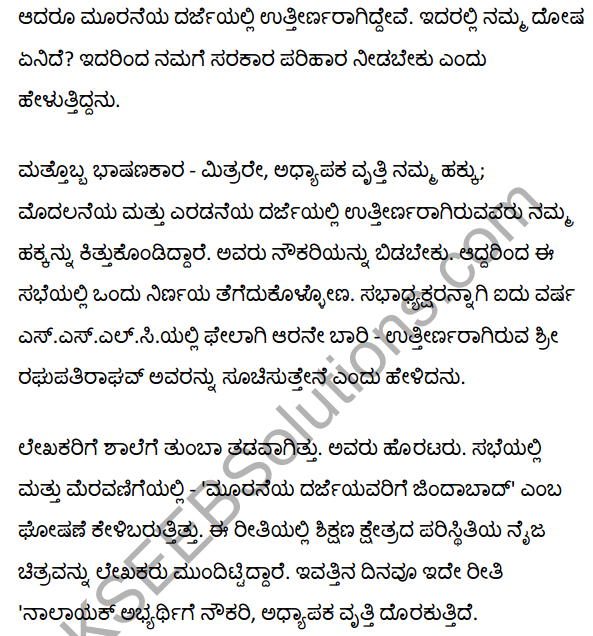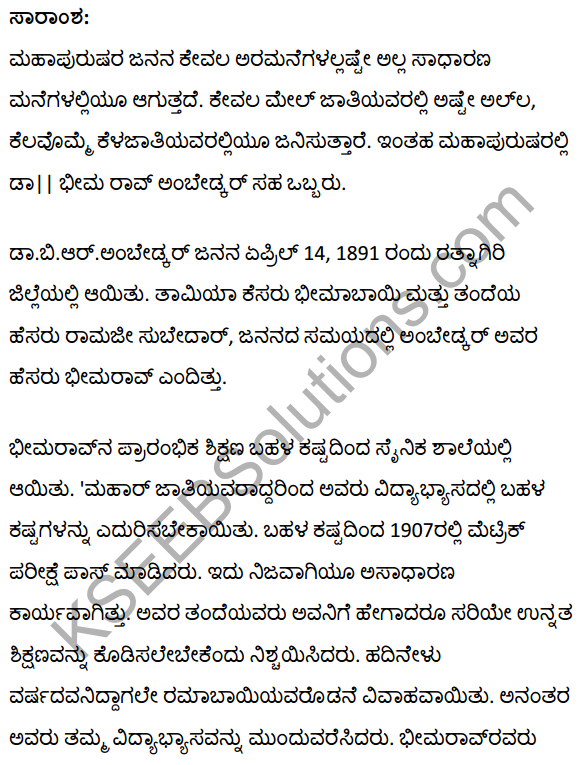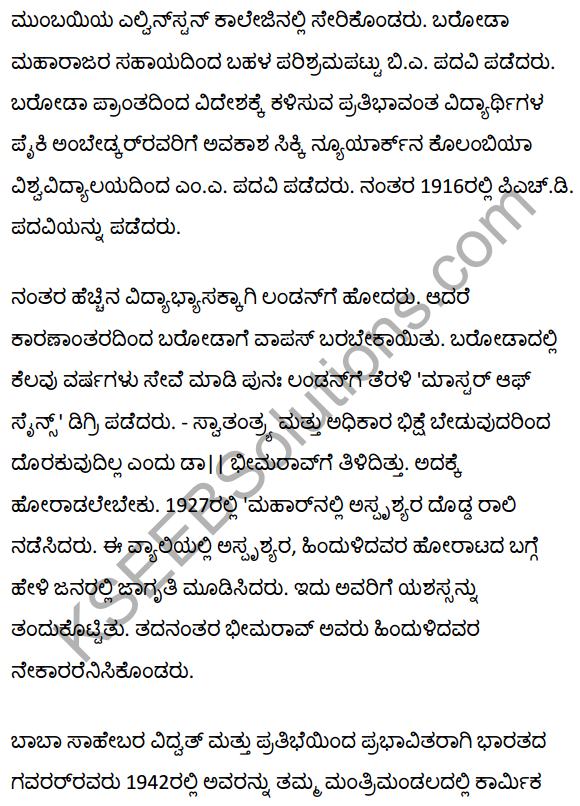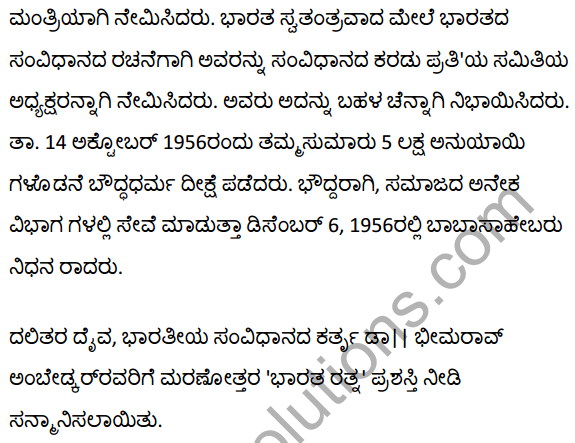You can Download Chapter 10 रिहर्सल Questions and Answers Pdf, Notes, Summary, 1st PUC Hindi Textbook Answers, Karnataka State Board Solutions help you to revise complete Syllabus and score more marks in your examinations.
Karnataka 1st PUC Hindi Textbook Answers Sahitya Vaibhav Chapter 10 रिहर्सल
रिहर्सल Questions and Answers, Notes, Summary
I. एक शब्द या वाक्यांश या वाक्य में उत्तर लिखिए:
प्रश्न 1.
वैद्य परमानन्द बीमार स्त्री को कितने दिन तक खाना न खाने के लिए कहते हैं?
उत्तरः
‘वैद्य परमानन्द बीमार स्त्री को पंद्रह दिन तक खाना न खाने की सलाह देते हैं।
प्रश्न 2.
किसान किसकी बीमारी के इलाज के लिए बैद्य परमानन्द के पास पहुंचता है?
उत्तरः
किसान गाय की बीमारी के इलाज के लिए वैद्य परमानन्द के पास पहुँचता है।
प्रश्न 3.
वैद्य परमानन्द हर बीमारी के लिए कौन-सी दवा देते हैं?
उत्तरः
वैद्य परमानन्द हर बीमारी के लिए अमर भास्कर चूर्ण देते हैं।
![]()
प्रश्न 4.
प्रोफेसर पांडुरंग बीमार स्त्री को कमजोरी दूर करने का क्या उपाय बताते हैं?
उत्तरः
प्रोफेसर पांडुरंग बीमार स्त्री से कहते हैं कि वह हिम्मत से आँखें बंद करके शेर से लड़ें, पहाड़ों पर चढ़ें, तूफान में समुद्र में कूदकर अपनी कमजोरी दूर कर सकती हैं।
प्रश्न 5.
प्रोफेसर पांडुरंग किसान को किसकी फोटो लाने के लिए कहते हैं?
उत्तरः
प्रोफेसर पांडुरंग किसान को गाय की फोटो लाने के लिए कहते हैं।
प्रश्न 6.
प्रोफेसर पांडुरंग किसे यमराज का सगा भाई कहते हैं?
उत्तरः
प्रोफेसर पांडुरंग वैद्य परमानंद को यमराज का सगा भाई कहते हैं।
प्रश्न 7.
प्रोफेसर पांडुरंग लड़के को होश में लाने के लिए कैसी कहानियाँ सुनाने की सलाह देते हैं?
उत्तरः
प्रोफेसर पांडुरंग लड़के को होश में लाने के लिए ऐसी कहानियाँ सुनाने की सलाह देते हैं कि बेहोश व्यक्तियों के होश में आने का वर्णन हो।
प्रश्न 8.
वैद्य परमानंद के अनुसार लड़के को क्या हुआ है?
उत्तरः
वैद्य परमानंद के अनुसार लड़के को सन्निपात हुआ है।
प्रश्न 9.
बेहोशी का अभिनय किसने किया?
उत्तरः
बेहोशी का अभिनय लड़के रमेश ने किया।
![]()
प्रश्न 10.
बेहोशी का अभिनय करने वाले लड़के का नाम लिखिए।
उत्तरः
बेहोशी का अभिनय करनेवाला रमेश था।
अतिरिक्त प्रश्नः
प्रश्न 11.
सदा घबराहट महसूस करना किसकी निशानी है?
उत्तरः
सदा घबराहट महसूस करना मौत की निशानी है।
प्रश्न 12.
वैद्य परमानंद बीमार स्त्री को कहाँ चंदन का लेप करने के लिए कहा?
उत्तरः
वैद्य परमानंद ने बीमार स्त्री को हृदय के भीतरी भाग पर चंदन का लेप करने के लिए कहा।
प्रश्न 13.
वैद्य परमानंद बेहोश बालक को कौन-सा रोग निश्चित करते हैं?
उत्तरः
वैद्य परमानंद बेहोश बालक को सन्निपात रोग निश्चित करते हैं।
प्रश्न 14.
‘रिहर्सल’ एकांकी के लेखक कौन हैं?
उत्तरः
‘रिहर्सल’ एकांकी के लेखक ओमप्रकाश ‘आदित्य’ हैं।
II. निम्नलिखित प्रश्नों के उत्तर लिखिए:
प्रश्न 1.
वैद्य परमानन्द बीमार स्त्री का इलाज किस प्रकार करते हैं?
उत्तरः
‘बीमार स्त्री इलाज के लिए जब वैद्य परमानंद के पास जाती है तो वे उसे उसका बचना मुशकिल है कहकर खूब डराते है। बाद में उससे अजीब से प्रश्न पूछते है जिसका बीमारी से संबंध ही नहीं। उसके हृदय पर चंदन का लेप लगाने के लिए कहते है। उसके हाथ में अमर भास्कर चूर्ण देकर उसे इस तरह खाने को कहते है वह सिधे पेट में न जाकर हृदय में जाए। फिर उसे पंद्रह दिन तक खाना न खाने की सलाह देते हैं।
![]()
प्रश्न 2.
वैद्य परमानंद गाय की बीमारी दूर करने का क्या उपाय बताते हैं?
उत्तरः
परमानंद ने किसान से कहा – तुम बीमार हो या तुम्हारी गाय, मेरे लिए एक ही बात है। लाओ, नब्ज दिखाओं। किसान बोला – जी, नब्ज मैं दिखाऊँ? परमानंद – और कौन दिखाएगा? गाय तुम्हारी बीमार है या किसी और की? नब्ज देखते हुए कहा – गाय की हालत चिंताजनक है। उसे शीघ्र चारा खिलाओ, नहीं तो मरे बिना नहीं मानेगी। उसे उसी का दूध निकालकर पिलाओ। यह अमर भास्कर चूर्ण ले जाओ, गरम पानी के साथ खा लेना। “मैं खाऊँ या गाय को खिलाऊँ?” “तुम भी खा लो, गाय को भी खिला दो। दोनों को लाभ पहुंचेगा।’
प्रश्न 3.
प्रोफेसर पांडुरंग बीमार स्त्री का इलाज किस ढंग से करते हैं?
उत्तरः
जब स्त्री प्रोफेसर साहब के पास पहुँचकर बोली – बीमार हूँ प्रोफेसर साहब! मेरा हृदय धड़कता है, घबराहट बहुत रहती है, कमजोरी कैसे दूर हो सकती है?, प्रोफेसर ने कहा – आपको भ्रम हो गया है, हृदय तो मेरा भी.धड़कता है, दिल की कमजोरी है, बीमारी नहीं है। हिम्मत रखिए, आँखें मूंद लीजिए, अब आप बीहड़ जंगल में हैं, हाथियों की चिंघाड़, शेरों की दहाड़, शेर आपकी ओर बढ़ रहा है, घबराइए मत, लड़िए उससे, अब इसे घूसे से मार दीजिए। उसके दाँत तोड़ दीजिए। स्त्री आँखें खोलती है। पांडुरंग जी! मैं चलती हूँ, नमस्ते। जाइए, महसूस कीजिए कि आप लक्ष्मीबाई की तरह तलवार चलाती बढ़ रही हैं। इस प्रकार प्रोफेसर बीमार स्त्री का इलाज करते है।
प्रश्न 4.
वैद्य और प्रोफेसर के आमने-सामने आने के बाद का दृश्य प्रस्तुत कीजिए।
उत्तरः
वैद्य परमानंद और प्रोफेसर पांडुरंग आमने-सामने आने के बाद एक-दूसरे पर व्यंग्य करते हैं। प्रोफेसर परमानंद को ‘यमराज का सगा भाई’ कहते हैं तो परमानंद प्रोफेसर को ‘वात-पित्त-कफ’ कहता है। प्रत्युत्तर व्यंग्य करते हुए वह कहता है कि तुम यदि किसी की नब्ज भी पकड़ लेते हो, तो उसकी जान चली जाती है। इस प्रकार आपस में हँसी-मजाक भी होती है और ताने भी दिए जाते हैं।
प्रश्न 5.
रमेश ने बेहोशी का अभिनय क्यों किया?
उत्तरः
रमेश अपने घर में बेहोश हो जाता है। उसके चिंतित पिता वैद्य परमानंद और प्रोफेसर पांडुरंग को बुला लाते है। परमानंद के अनुसार लड़के को सन्निपात है तथा प्रोफेसर पांडुरंग के अनुसार उसे स्नायुरोग है। यह सब सुनकर लड़का घबडा जाता है और चादर फेंककर उठते हुए कहता है कि वह पूरी तरह होश में है। न उसे भ्रम है और न उसे कुछ महसूस करने की जरूरत है। स्कूल में होने वाले नाटक जिसमें उसे दो घंटे बेहोशी का अभिनय करना है, वह उसीकी रिहर्सल कर रहा था।
प्रश्न 6.
वैद्य परमानंद का चरित्र-चित्रण कीजिए।
उत्तरः
वैद्य परमानंद का आयु लगभग 50 वर्ष है। आँखों पर चश्मा, लम्बी दाढ़ी, झुर्सदार मूंछे हैं। परमानंद स्वयं समझते हैं कि उनके रोगी उनके पास दुबारा नहीं लौटते। हर प्रकार के रोग के लिए उनके पास एक ही दवा है और वह है ‘अमर भास्कर चूर्ण’। उन्हें इस बात की परवाह नहीं कि उनकी दवा से कोई रोगी ठीक होगा या नहीं, उन्हें तो बस सभी को खिलाना है ‘अमर भास्कर चूर्ण’। यहाँ तक कि गाय को भी वही चूर्ण खिलाने को कहते हैं।
![]()
प्रश्न 7.
प्रोफेसर पांडुरंग का चरित्र-चित्रण कीजिए।
उत्तरः
प्रोफेसर पांडुरंग की उम्र बयालीस वर्ष है। उनकी दाढ़ी फ्रेंचकट है, मूंछे साफ, आँखों पर मोटे फ्रेम का चश्मा लगाते हैं। सूट पहनते हैं और टाई लगाते हैं। बीमारियों का इलाज करते हैं। बीमार स्त्री को आँखें बंद करके जंगल में होने का महसूस करने को कहते हैं और शेर को घूसे से मारने को कहते हैं। किसान की बीमार गाय के इलाज के लिए उसका फोटो लाने को कहते हैं।
अतिरिक्त प्रश्नः
प्रश्न 8.
प्रोफेसर पांडूरंग किसान को क्या हिदायतें देता हैं?
उत्तरः
प्रोफेसर पांडुरंग के सामने एक किसान अपनी गाय की बीमारी की समस्या लेकर आता है। तब प्रोफेसर किसान को कहते हैं- अपनी गाय का चेहरा लेकर आना। गाय का चेहरा देखे बिना मैं बीमारी का निदान नहीं कर सकता। चेहरा न ला सको तो उसका एक फोटो खिंचवाकर ही ले आना।
III. निम्नलिखित वाक्य किसने किससे कहे?
प्रश्न 1.
परहेज ही तो असली इलाज है।
उत्तरः
यह वाक्य वैद्य परमानन्द ने बीमार स्त्री से कहा।
प्रश्न 2.
तुम भी खा लेना, गाय को भी खिला देना।
उत्तरः
यह वाक्य वैद्य परमानन्द ने किसान से कहा।
प्रश्न 3.
नहीं, कई बेटे अपने बाप से भी बड़े हो जाते हैं।
उत्तरः
यह वाक्य वैद्य परमानन्द ने अध्यापक से कहा।
प्रश्न 4.
ठीक तो हो जायेगा, पर होश में नहीं आयेगा।
उत्तरः
यह वाक्य वैद्य परमानन्द ने रमेश की माँ से कहा।
प्रश्न 5.
तुझे क्या हो गया था मेरे लाड़ले।
उत्तरः
यह वाक्य माँ ने अपने पुत्र रमेश से कहा।
अतिरिक्त प्रश्नः
प्रश्न 6.
“यही तो मौत की निशानी है।”
उत्तरः
इस वाक्य को वैद्य परमानंद ने स्त्री से कहा।
![]()
प्रश्न 7.
“आप गिर नहीं रहे हैं। आप महसूस कीजिए कि नहीं गिर रहे हैं।”
उत्तरः
इस वाक्य को प्रोफेसर पांडुरंग ने वैद्य परमानन्द से कहा।
प्रश्न 8.
“आपको भ्रम हो गया है, आप बीमार नहीं है।”
उत्तरः
प्रोफेसर पांडुरंग बीमार स्त्री से कहते हैं।
प्रश्न 9.
“घबराइए मत। आँखें मत खोलिए, आप शेर से लडिए।”
उत्तरः
प्रोफेसर पांडुरंग बीमार स्त्री से कहते हैं।
प्रश्न 10.
“इसकी नब्ज़ बता रही है कि यह बेहोश है।”
उत्तरः
वैद्य परमानन्द ने पिता से कहा।
प्रश्न 11.
“इसका चेहरा कह रहा है कि यह होश में है।”
उत्तरः
प्रोफेसर पांडुरंग ने वैद्य परमानंद से कहा।
IV. ससंदर्भ स्पष्टीकरण कीजिएः
प्रश्न 1.
मरना तो कोई नहीं चाहता, लेकिन मैंने अपने रोगियों को अक्सर मरते देखा है।
उत्तरः
प्रसंग : प्रस्तुत गद्यांश हमारी पाठ्य पुस्तक ‘साहित्य वैभव’ के ‘रिहर्सल’ नामक पाठ से लिया गया है जिसके लेखक ओमप्रकाश आदित्य हैं।
संदर्भ : बीमार स्त्री जब वैद्य परमानंद के पास इलाज के लिए आती है तब स्त्री की नब्ज पकड़ते हुए परमानंद यह वाक्य कहते हैं।
स्पष्टीकरण : वैद्य परमानन्द के पास एक अधेड़ उम्र की स्त्री आती है और आकर बेंच पर बैठती है। वह बीमार है। स्त्री वैद्य परमानन्द को बतलाती है कि उसका दिल धड़कता है, नीन्द नहीं आती, आदि-आदि। यह सुनकर वैद्य जी उस स्त्री से कहते हैं कि उसका बचना मुश्किल हैं। स्त्री मरना नहीं चाहती। वैद्य से प्रार्थना करती है कि उसे बचाले। तब वैद्य परमानंद उक्त वाक्य को स्त्री से कहते हैं।
प्रश्न 2.
हृदय का गुण ही धड़कना है।
उत्तरः
प्रसंग : प्रस्तुत गद्यांश हमारी पाठ्य पुस्तक ‘साहित्य वैभव’ के ‘रिहर्सल’ नामक पाठ से लिया गया है जिसके लेखक ओमप्रकाश आदित्य हैं।
संदर्भ : प्रोफेसर पाण्डुरंग के पास बीमार स्त्री जब इलाज के लिए फिर आती है तब पाण्डुरंग कहते हैं कि उसे भ्रम हो गया है। स्त्री बतलाती है कि उसका हृदय धड़कता है।
स्पष्टीकरण : जब बीमार स्त्री ने कहा कि उसका हृदय धड़कता है तो प्रोफेसर पांडुरंग ने उससे कहा – हृदय तो मेरा भी धड़कता हैं, दुनिया में हर आदमी का धड़कता है। इसमें नयी बात क्या है? हृदय का काम ही धड़कना है। आप को दिल की कमजोरी है, बीमारी नहीं है जिसे धैर्य और कल्पना के सहारे ठीक किया जा सकता है।
![]()
प्रश्न 3.
मुझे डर है कि कहीं यहाँ बैठे-बैठे मेरा दिल धड़कना बंद न कर दे।
उत्तरः
प्रसंग : प्रस्तुत गद्यांश हमारी पाठ्य पुस्तक ‘साहित्य वैभव’ के ‘रिहर्सल’ नामक पाठ से लिया गया है जिसके लेखक ओमप्रकाश आदित्य हैं। – संदर्भ : प्रोफेसर के इलाज के दौरान स्त्री झटके के साथ उठकर तेजी से बाहर जाते हुए यह वाक्य कहती है।
स्पष्टीकरण : जब प्रोफेसर ने कहा – आपका दिल लोहे की तरह मजबूत हो जाएगा, तब स्त्री ने कहा – पांडुरंग जी! मुझे डर है कि कहीं यहाँ बैठे-बैठे मेरा दिल धड़कना बन्द न कर दे। मैं चलती हूँ, नमस्ते।
प्रश्न 4.
इसे भ्रम हो गया है कि यह बेहोश है।
उत्तरः
प्रसंग : प्रस्तुत गद्यांश हमारी पाठ्य पुस्तक ‘साहित्य वैभव’ के ‘रिहर्सल’ नामक पाठ से लिया गया है जिसके लेखक ओमप्रकाश आदित्य हैं।
संदर्भ : माँ कहती है कि यह बेहोश है और आपको कहानियाँ सूझ रही है प्रोफेसर परमानन्द तब कहते हैं कि इसे भ्रम हुआ है कि यह बेहोश है। .
स्पष्टीकरण : जब माँ कहती है – यह बेहोश है, आपको कहानियों की सूझ रही है। प्रोफेसर ने कहा – यह बेहोश नहीं है। परमानंद ने कहा – तो क्या है? तब प्रोफेसर ने कहा – इसे भ्रम हो गया है कि यह बेहोश है। असल में यह होश में ही है।
प्रश्न 5.
सन्निपात है वैद्य परमानंद को और स्नायुरोग है प्रोफेसर पांडुरंग को।
उत्तरः
प्रसंग : प्रस्तुत गद्यांश हमारी पाठ्य पुस्तक ‘साहित्य वैभव’ के ‘रिहर्सल’ नामक पाठ से लिया गया है जिसके लेखक ओमप्रकाश आदित्य हैं।
संदर्भ : जब लड़का बेहोश हो जाता है तभी दोनों आपस में एक दूसरे से कहते हैं कि इसे स्नायु रोग है तो दूसरा इसे सन्निपात रोग कहता है।
स्पष्टीकरण : जब माँ ने कहा – हाय राम! ये तो रोग पर रोग बढ़ाये जा रहे हैं, तब लड़का कहता है – सन्निपात है वैद्य परमानंद को और स्नायुरोग है प्रोफेसर पांडुरंग को। मैं पूरी तरह होश में हूँ। न मुझे भ्रम है और न कुछ महसूस करने की जरूरत।
अतिरिक्त प्रश्नः
प्रश्न 6.
“अरे, आग लगे तेरी रिहर्सल को। तू बीस-तीस मिनट और ऐसे ही रहता तो मेरी रिहर्सल हो जाती
उत्तरः
प्रसंग : प्रस्तुत गद्यांश हमारी पाठ्य पुस्तक ‘साहित्य वैभव’ के ‘रिहर्सल’ नामक पाठ से लिया गया है। इसके लेखक ओमप्रकाश आदित्य हैं।
संदर्भ : माँ अपने लड़के रमेश को डाँटते हुए कहती है।
स्पष्टीकरण : रमेश अचानक होश में आ जाता है। तब रमेश की माँ उसे अंक में भरकर पूछती है – तुझे क्या हो गया था मेरे लाडले। तब रमेश कहता है – मैं तो स्कूल में होने जा रहे नाटक में बेहोशी के अभिनय के लिए रिहर्सल कर रहा था। तब माँ गुस्से में कहती है, अरे, आग लगे तेरी रिहर्सल को। तू बीस-तीस मिनट और ऐसे ही रहता तो मेरी रिहर्सल हो जाती।
प्रश्न 7.
“कौन? वैद्य परमानंद! यमराज का सगा भाई।”
उत्तरः
प्रसंग : प्रस्तुत गद्यांश हमारी पाठ्य पुस्तक ‘साहित्य वैभव’ के ‘रिहर्सल’ नामक पाठ से लिया गया है जिसके लेखक ओमप्रकाश आदित्य हैं।
संदर्भ : प्रोफेसर, अध्यापक के घर अचानक वैद्य परमानंद को देखकर कहते हैं।
स्पष्टीकरण : वैद्य परमानन्द बारह वर्षीय अचेत लड़के का ईलाज कर रहे हैं। घरवाले सभी चिन्तित है। तभी लड़के की बहन प्रोफेसर पांडुरंग को भी बुला लाती है। प्रोफेसर पांडुरंग वहाँ वैद्य को देखकर कहते हैं – कौन? वैद्य परमानंद! यमराज का सगा भाई! वे इसलिए ऐसा कहते हैं कि परमानंद के द्वारा इलाज किया गया व्यक्ति जिन्दा नहीं बचता है। वे साक्षात यमराज हैं।
प्रश्न 8.
“गाय बीमार है तो तुम किसलिए आए हो? गाय का इलाज क्या तुम्हारी शक्ल देखकर करूँ?”
उत्तरः
प्रसंग : प्रस्तुत गद्यांश हमारी पाठ्य पुस्तक ‘साहित्य वैभव’ के ‘रिहर्सल’ नामक पाठ से लिया गया है जिसके लेखक ओमप्रकाश आदित्य हैं।
संदर्भ : गाय की बीमारी लेकर आये किसान को प्रोफेसर पांडुरंग यह वाक्य कहते हैं।
स्पष्टीकरण : एक किसान प्रोफेसर पांडुरंग को राम-राम करता है। तब प्रोफेसर उसकी शक्ल देखकर कहते हैं – तुम्हे किसी तरह की कोई बीमारी नहीं है। किसान कहता हैं मैं आज तक बीमार नहीं हुआ। पिछले दस दिनों से मेरी गाय बीमार है। तब प्रोफेसर कहते हैं – गाय बीमार है तो तुम किसलिए आए हो? गाय का इलाज क्या तुम्हारी शक्ल देखकर करूँ?
![]()
प्रश्न 9.
“अच्छा। उसे उसी का दूध निकालकर पिलाओ।”
उत्तरः
प्रसंग : प्रस्तुत गद्यांश हमारी पाठ्य पुस्तक ‘साहित्य वैभव’ के ‘रिहर्सल’ नामक पाठ से लिया गया है जिसके लेखक ओमप्रकाश आदित्य हैं।
संदर्भ : वैद्य परमानंद बीमार गाय की समस्या लेकर आए किसान से यह वाक्य कहते हैं।
स्पष्टीकरण : किसान वैद्य परमानंद जी से कहता है – वैद्य जी, मेरी गाय बीमार है। दस दिन से न चारा खाती है न दूध देती है। वैद्य जी किसान कि नब्ज देखने लगते है – गाय को शीघ्र चारा खिलाओं नहीं तो मरे बिना नहीं रह सकती। किसान कहता है उसे चारा नहीं खाने का ही . तो रोग है। तब वैद्य परमानंद कहते हैं – उसे उसी का दूध निकालकर पिलाओं।
प्रश्न 10.
“हृदय के भीतरी भाग पर चंदन का लेप कीजिए।’
उत्तरः
प्रसंग : प्रस्तुत गद्यांश हमारी पाठ्य पुस्तक ‘साहित्य वैभव’ के ‘रिहर्सल’ नामक पाठ से लिया गया है जिसके लेखक ओमप्रकाश आदित्य हैं।
संदर्भ : वैद्य परमानंद दिल की बीमारी से पीड़ित स्त्री को कहते हैं।
स्पष्टीकरण : एक स्त्री वैद्य परमानंद के पास दिल की धड़कन की बीमारी बताती हैं। तब वैद्य जी उसे अजीब सलाह देते हैं। वे नब्ज देखकर कहते हैं – हृदय के भीतरी भाग पर चंदन का लेप कीजिए। स्त्री पूछती है भीतरी भाग पर? तब वे उसे अमर भास्कर का चूर्ण देते हुए कहते हैं – इसे इस तरह खाइये कि पेट में न जाकर सीधा हृदय में जाये।
V. अन्य लिंग रूप लिखिए:
प्रश्न 1.
हाथी, शेर, लड़का, गाय, पिता, अध्यापक, भगवान।
उत्तरः
- हाथी – हथिनी
- शेर – शेरनी
- लड़का – लड़की
- गाय – बैल
- पिता – माता
- अध्यापक – अध्यापिका
- भगवान – भगवती।
VI. अन्य वचन रूप लिखिए:
प्रश्न 1.
दुकान, घंटा, किताब, मूंछ, मुद्रा, सपना।
उत्तरः
- दुकान – दुकानें
- घंटा – घंटे
- किताब – किताबें
- मूंछ – मूंछे
- मुद्रा – मुद्राएँ
- सपना – सपने।
VII. विलोम शब्द लिखिए:
प्रश्न 1.
बेहोश, मोटा, मौत, शीघ्र, छोटा।
उत्तरः
- बेहोश × होश
- मोटा × पतला
- मौत × बेमौत (जिंदगी)
- शीघ्र × विलम्ब
- छोटा × बड़ा।
रिहर्सल लेखक परिचयः
हिन्दी साहित्य जगत के प्रसिद्ध हास्य-व्यग्य रचनाकार ओमप्रकाश ‘आदित्य’ का जन्म ‘ 5 नवंबर 1936 को रणसीका, गुड़गाँव (हरियाणा) में हुआ। आपने दिल्ली विश्वविद्यालय से एम.ए. (हिन्दी) की उपाधि प्राप्त की। गंभीर कविताओं से प्रारंभ करके हास्य-व्यंग्य के क्षेत्र में अवतरित होनेवाले ‘आदित्य’ जी ने आज कवि के रूप में हिन्दी मंच को और निबंधकार के रूप में पाठक वर्ग को पूरी तरह जकड़ लिया है। हास्य-एकांकी लेखन के क्षेत्र में भी आपने अपने जौहर दिखाए हैं। आपकी मृत्यु 8 जून 2009 को भोपाल के नजदीक कार दुर्घटना में हुई।
![]()
प्रमुख कृतियाँ: ‘थर्ड डिवीज़न’, ‘इधर भी गधे हैं, उधर भी गधे हैं’, ‘तोता एंड मैना’, ‘उल्लू का इंटरव्यू’, ‘माडर्न शादी’, ‘घट-घट व्यापी भ्रष्टाचार’, ‘गौरी बैठी छत पर’ आदि सम्मिलित हैं। प्रस्तुत एकांकी ‘श्रेष्ट हास्य-व्यंग्य एकांकी – काका हाथरसी’ डा. गिरिराज शरण अग्रवाल से संकलित की गई है। इस एकांकी में वैद्य परमानन्द तथा प्रोफेसर पांडुरंग अनोखे ढंग से मरीजों का इलाज करते हैं। रमेश के बेहोशी के अभिनय ने एकांकी को न सिर्फ हास्य-व्यंग्य से सराबोर किया है बल्कि वैद्य और प्रोफेसर की सच्चाई को भी भलीभाँति उजागर किया है।
रिहर्सल Summary in Hindi
पात्रवर्गः
- एक बीमार स्त्री
- वैद्य परमानन्द
- किसान
- अध्यापक
- प्रोफेसर पांडुरंग
- एक बालक (रमेश)
- बालक के पिता, माता आदि।
श्री ओमप्रकाश ‘आदित्य’ हिन्दी में एक सफल एकांकीकार हैं। इन्होंने ‘रिहर्सल’ एकांकी में दो वैद्यों के अशास्त्रीय चिकित्सा-विधान का मजाक उड़ाया है। लेखक ने अपने हास्य-चातुर्य से वातावरण को आल्हादकारी बनाया है। लेखक का संकेत है कि ऐसे अयोग्य वैद्यों से दूर रहना चाहिए।
परमानंद एक आयुर्वेद वैद्य हैं। वे हर रोग की रामबाण औषधि ‘अमर भास्कर चूर्ण’ मानते हैं। हर किसी रोगी को, हर किसी बीमारी के लिए परमानंद उन्हें यही दवा देते हैं। एक बार एक किसान अपनी गाय लेकर वैद्य परमानंद के पास आया। तुरंत वैद्य ने ‘अमर भास्कर चूर्ण’ उसके हाथ में रख दिया। किसान ने चकित होकर कहा कि वैद्यजी! बीमारी मुझे नहीं, मेरी गाय को है। तब वैद्यजी ने तड़ाक से जवाब दिया कि बीमारी उसे है या उसकी गाय को, कोई फर्क नहीं पड़ता। यही दवा गाय को पिलाओ। गाय ठीक हो जाएगी। किसान अवाक् रह गया।
प्रोफेसर पांडुरंग अजीब, ढंग के वैद्य हैं। जब कोई मरीज उसके पास आता है, वह रोगी से कई उलटे-सीधे सवाल करके उसकी जान खाता है। मरीज की शिकायत सुने बिना प्रोफेसर पांडुरंग दवा देता है। एक बीमार स्त्री दिल की धड़कन की शिकायत लेकर प्रोफेसर पांडुरंग के पास आई।
प्रोफेसर ने उससे कहा कि दिल की धड़कन तो होगी है। वह तो उसका गुण धर्म है। आँधी-तूफान में, शेर-बाघ के सामने उसे धैर्य से खड़े होना चाहिए। यह दिल कुछ नहीं कर सकता। हर स्त्री को दिलेर बनने की सलाह देता है। वह स्त्री अपना सिर पीटते हुए चली जाती है।
रमेश नामक बारह साल का लड़का बेहोश हो गया था। वैद्य परमानंद उस लड़के की जाँच करने उसके घर आता है। वह लड़के की जाँच करके ऊट-पटांग बातें करने लगता है। इतने में लड़के की बहन प्रोफेसर पांडुरंग को बुला लाती है। दोनों वैद्य आपस में छींटाकशी करने लगते हैं। आपस में वे दोनों झगड़ने लगते हैं। इधर लड़के के माँ-बाप परेशान होते हैं। मगर वैद्यों का झगड़ा खत्म नहीं होता। इतने में बेहोश लड़का उठ बैठता है। यह देखकर सब लोग दंग रह जाते हैं। तब लड़का रमेश कहता है कि अगले दिन स्कूल के वार्षिकोत्सव नाटक में बेहोशी का अभिनय करना था। ‘रिहर्सल’ के तौर पर उसने बेहोश होने का नाटक किया।
![]()
यह सुनकर वैद्य परमानंद जी सचमुच बेहोश होने लगते हैं और प्रोफेसर पांडुरंग उसे उठाने लगते है|
रिहर्सल Summary in Kannada
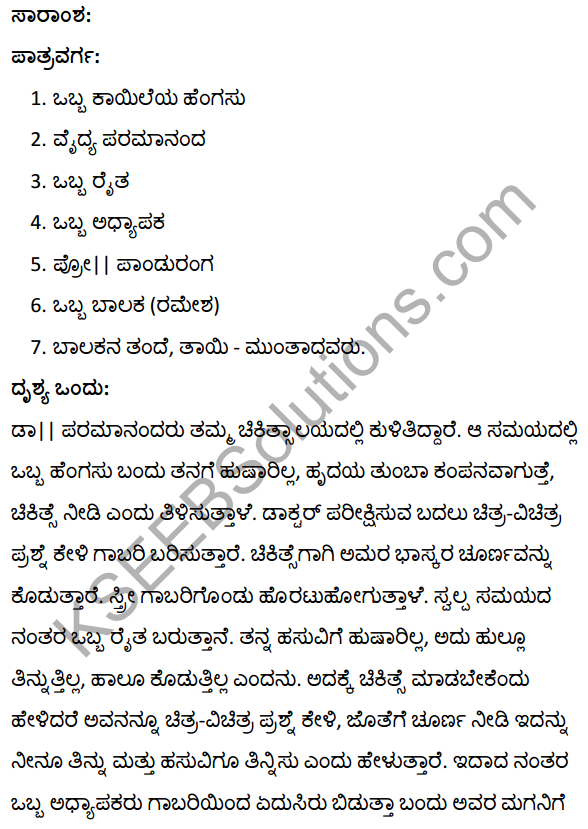
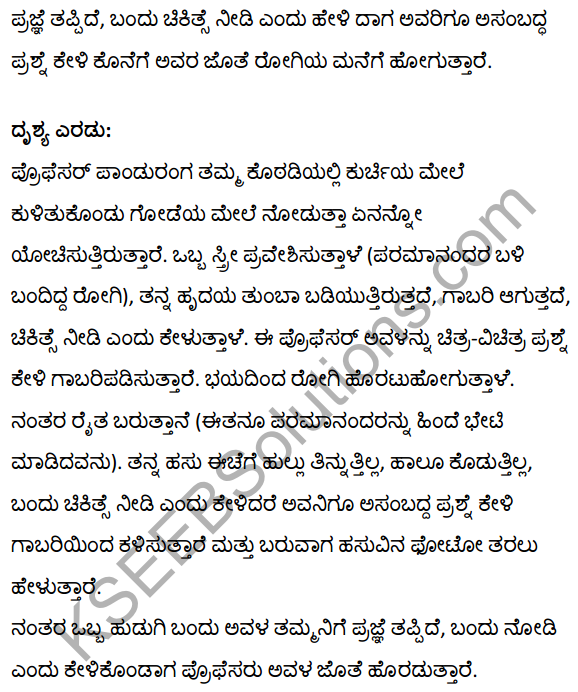
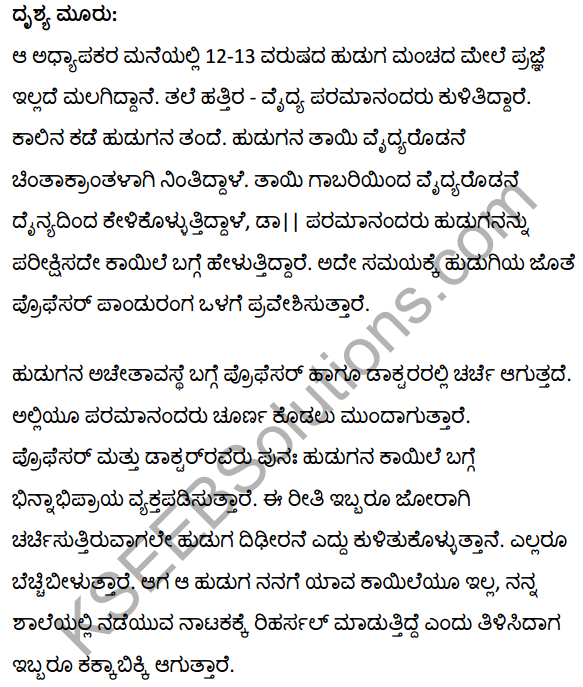
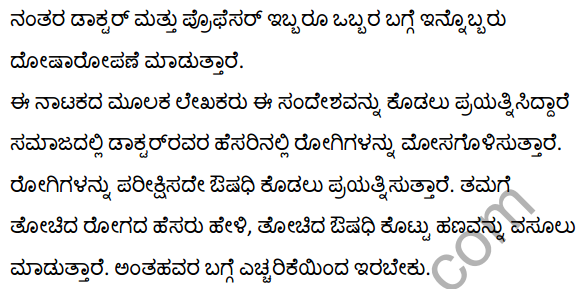
रिहर्सल Summary in English
Characters:
- A sick woman
- Doctor Paramanand
- Farmer
- Teacher
- Professor Pandurang
- A boy (Ramesh)
- The boy’s parents
Shri Omprakash ‘Aditya’ is a successful Hindi playwright. This play, ‘Rehearsal is a satire on the unscientific medical practices of two doctors. With his brilliant comic timing, the playwright has created an atmosphere of chivalry and light humour. The play gives us the message that we must be wary of such untrained or unskilled doctors.
Paramanand is an ayurvedic doctor. He considers ‘Amar Bhaskar Churna’ to be the miraculous remedy for every disease. Whatever be the disease and whoever be the patient, Paramanand would always recommend the same medicine to everyone. Once a farmer came to Paramanand with his sick cow. Immediately, Paramanand put ‘Amar Bhaskar Churna’ in the farmer’s hand. The farmer was taken aback and he told Paramanand that he was not the one who was ill, but it was rather his cow that was ill. Paramanand replied immediately that it did not matter whether the illness plagued the farmer or his cow. He told the farmer to give the medicine to the cow, and that the cow would get well. The farmer was left speechless.
Professor Pandurang is a strange kind of doctor. Whenever a patient visits him, he asks ridiculous questions and harasses his patients. He prescribes medicines without listening to the complaints of the patient. Once, a woman patient visited Professor Pandurang with a complaint. about her heartbeat. Professor Pandurang told the woman that the heart would always beat – it was the heart’s basic characteristic. According to him, during a storm, or when confronted by a lion or tiger, the heart should stand its ground with courage. He told her that the heart cannot do anything as such and he advised her that all women must try to be courageous. The woman left, beating her own forehead for visiting such a doctor.
![]()
Once, a twelve-year-old boy, Ramesh, fainted. Doctor Paramanand arrived at the boy’s house in order to check up on the boy. Just then, the boy’s sister arrived, having brought along Professor Pandurang to treat her brother. Both the doctors then began to bicker between themselves. Soon, they began to argue about the disease the boy was suffering from. The boy’s parents began to get worried. But, the doctors did not stop fighting. Just then, the boy, Ramesh, got up. This surprised everyone and they were all stunned. Then, Ramesh explained that he had to enact a fainting scene in the Annual school play which was to be held the following day. He explained that he wanted to rehearse, and therefore he acted as he had fainted.
Hearing this,Vaidya Paramanand fainted. Professor Pandurang tried to wake him up.
कठिन शब्दार्थः
- नब्ज – नाड़ी, रक्त वाहिनी शिराएँ;
- परहेज – हानिकारक एवं अहितकर वस्तुओं का सेवन न करना;
- बीहड़ – विषम, घना, ऊबड़-खाबड़;
- पैताने – वह दिशा जिधर पैर फैलाकर सोया जाए;
- अंक में भरना – गले लगाना, लिपटाना।
